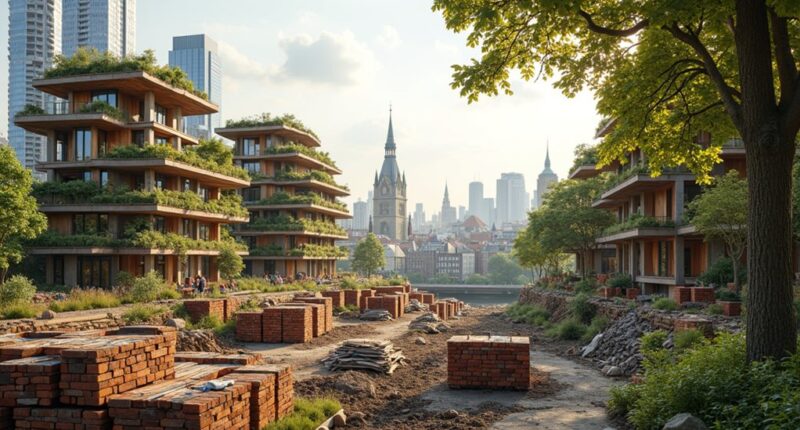London is flexing its muscles as a leader in sustainable construction, with innovative approaches in material reuse and recycling. The city boasts ambitious projects like Crossrail, targeting a 90% recovery rate, and Harold Hill station, showcasing 80% structural reuse. Clever techniques such as cement-free concrete and cross-laminated timber are lowering emissions. Meanwhile, regulations like the Future Homes Standard push for eco-friendly practices. So, what’s next on this green journey? Buckle up; the trend is just getting started!
Quick Overview
- Transport for London aims for 90% recycling of construction waste, showcasing leadership in sustainable practices.
- Harold Hill station achieved 80% structural reuse, setting a benchmark for future projects.
- Innovations like cement-free concrete and all-electric systems reduce emissions, aligning with net-zero goals.
- The Future Homes Standard mandates new builds to cut carbon emissions, promoting eco-friendly construction.
- Tax incentives for using recycled materials encourage developers to adopt sustainable practices in London’s construction industry.
Advancements in Material Reuse and Recycling Practices
In the bustling world of construction, where bricks and mortar meet sustainability, advancements in material reuse and recycling practices are paving the way for a greener future in London.
With Transport for London aiming to recycle at least 90% of construction waste, and Crossrail pushing for a 90% recovery rate, the stakes are high. Projects like Harold Hill station boast an impressive 80% structural reuse, proving that it’s not just talk. Additionally, the UK’s overall recycling rate for waste from households has increased to 44.6% in 2023, showcasing a growing commitment to sustainability across various sectors. Notably, 74.3Mt of recycled and secondary aggregates were utilized in 2023, reflecting the industry’s shift towards more sustainable practices. Many developers are now incorporating green building ratings into their construction plans to ensure compliance with sustainable standards.
However, challenges remain, like limited space for sorting materials. Yet, the industry’s commitment to transparency and accountability is the secret sauce making this sustainable recipe more palatable.
Innovations Driving Net-Zero Construction Goals
A remarkable shift is underway in the construction industry, where innovations are not just buzzwords but essential strategies driving the pursuit of net-zero construction goals.
Smart building systems track energy use like a fitness tracker for your home, while all-electric systems powered by renewable sources ditch the gas boilers for good. In fact, the use of cement-free concrete has been shown to reduce emissions by 64% compared to traditional concrete. To further support this movement, the LETI Initiative emphasizes the need to achieve Operational Zero Carbon by 2030 for all new buildings.
Smart building systems monitor energy like a home fitness tracker, while all-electric solutions eliminate gas boilers for a greener future.
Modular construction speeds things up, reducing waste like a well-timed joke in a conversation. Incorporating ETFE materials in modular designs provides superior insulation while significantly reducing overall building weight.
Meanwhile, low-carbon materials like cross-laminated timber and recycled concrete are stepping up to the plate, proving that sustainability can be sturdy.
With these innovations, the future looks bright—like a solar panel soaking up the sun!
Regulatory Frameworks and Financial Incentives for Sustainability
Maneuvering the regulatory landscape for sustainable construction in London can feel a bit like trying to find your way through a maze—challenging but ultimately rewarding.
The Future Homes Standard and Planning for Sustainability guarantee new builds substantially cut carbon emissions and embrace eco-friendly practices.
Think of it as a sustainability boot camp, where every brick must pull its weight.
Financial incentives, like tax breaks for using recycled materials, sweeten the deal.
With regulations evolving faster than a trendy café’s menu, stakeholders must stay sharp. Carbon Border Adjustment Mechanism ensures that importers are incentivized to reduce embedded emissions in their materials.
Furthermore, developments must adhere to local plan strategic objectives to address sustainability early in the development process.
Projects must comply with compliance requirements established by major environmental laws that govern resource conservation and pollution prevention.
After all, a greener London isn’t just a dream; it’s becoming the new construction reality.









